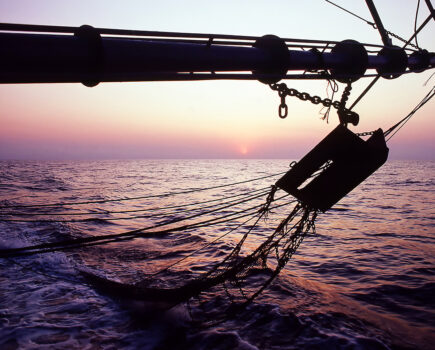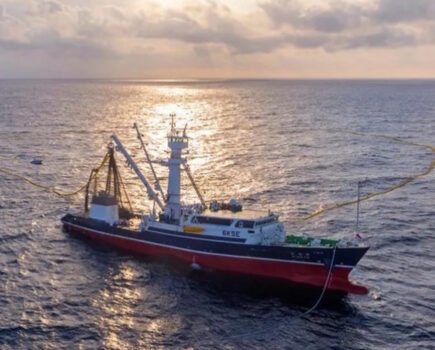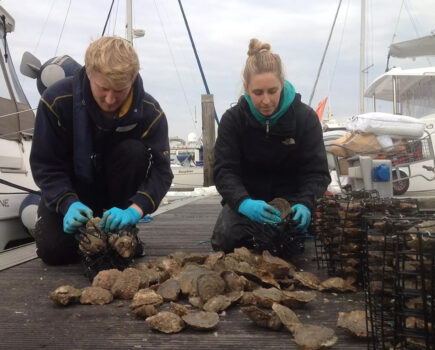With a third round of applications drawing to a close, Fishing News is taking a closer look at some of the projects already supported by the UK Seafood Innovation Fund (SIF). This week’s featured project, from the University of East Anglia, is developing an epigenetic ageing tool to support sustainable lobster harvesting

Scientists at the University of East Anglia are investigating new methods to more accurately age European lobster stocks, to help improve stock management in the future.
Sustainable management of fish and shellfish requires an understanding of the number of individuals of different ages in a stock. Such age data can then be used to estimate individual growth rates, mortality rates and stock recruitment, allowing future stock abundance to be predicted. Accurate age estimation therefore underpins effective management, and there are many examples where inaccurate ageing has contributed to the overexploitation of a stock.
In fish and shellfish, age is usually determined using growth rings laid down in scales, ear bones (otoliths) or shells, or size, but this is not possible for crustaceans.
Dr Eleanor Fairfield, whose PhD research focused on developing methods for ageing crustaceans, said: “Lobsters have hard, inelastic shells, and so in order to grow they must shed their old shell and replace it with a new one. However, lobsters of the same age don’t always grow and moult at the same time. For example, lobsters with more food or in warmer waters can grow more quickly, which makes it really hard to know how old lobsters actually are.”
Several novel methods of crustacean ageing have been trialled over recent decades, but none have proved reliable enough to implement in management scenarios. Thus, age determination is a significant challenge for performing reliable crustacean stock assessments, and may ultimately impact our ability to sustainably harvest stocks.
Using funding from the Seafood Innovation Fund (SIF), the University of East Anglia scientists aimed to develop a novel method of determining age of European lobsters by identifying and measuring epigenetic changes in DNA that accumulate with age. Such epigenetic modifications have been previously used to develop DNA-based ageing models for humans and some other vertebrates, and therefore show great promise as a non-invasive and accurate method of age determination.
To develop the method, the scientists used groups of known-age lobsters provided by project collaborators at the National Lobster Hatchery in Padstow, Cornwall, which ranged in age from a few days to just over four years old. They then measured the age-related changes in the lobster’s DNA by bisulphite converting and sequencing the DNA to identify epigenetic modifications that were associated with age.
This first stage of the research generated extremely encouraging results, and they were able to identify many sites within the DNA that could be combined and used to build a statistical model to predict age.
Dr Martin Taylor, the scientist in charge of the project, said: “We identified a very strong relationship between age and DNA modifications, which allowed us to accurately estimate the ages of individual lobsters to plus or minus 1.6 months.”
The next step was to apply the ageing model to wild lobsters that were over the legal landing size, but of unknown age. Using the model, these wild lobsters were predicted to be between just under three years to just over four years old, with an average age of 40 months. These ages are slightly lower than expected (mark recapture studies from the 1980s estimated that lobsters reach legal landing size at four to seven years old).
Dr Taylor said: “We were very pleased with the wild lobster ageing data. They are realistic ages, and it is possible that growth rates are higher and maturation sizes are now lower than they were in the 1980s as a result of warming seas and changing food webs.”
Having received further funding from SIF, the scientists are now focusing on developing and refining this promising method.
Firstly, they are extending the range of known-age lobsters that the model has been built on. European lobsters may live for decades, and the first ageing model was based on a relatively small age range (0-4 years old). By maintaining lobsters in captivity in the National Lobster Hatchery, they have been able to extend the range to 5.5 years, with plans to maintain individuals even longer into the future.
Secondly, the scientists are interested in how differences in the environment affect the rate of DNA change associated with ageing. To investigate this, juvenile lobsters have been placed in specially designed sea cages at two sites in the UK. These will be harvested in early 2022, and the rate of change in their DNA will be measured. If an ageing methodology is to be widely adopted, it should be applicable across geographic regions, and not be dramatically affected by the environment.
Finally, the scientists are testing known-age lobsters from other hatcheries in Europe to improve the geographic range of samples included in their ageing model.
Dr Carly Daniels, head of production science and development at the National Lobster Hatchery, said: “Having an accurate indication of lobster age will help fisheries scientists and conservationists alike to understand, manage and conserve our vulnerable lobster stocks, working hand in hand with proactive fisheries management strategies, such as stock enhancement.”
This research was supported with funding from the UKRI Biotechnology and Biological Sciences Research Council and the UK Seafood Innovation Fund.
The first results were recently published in the journal Evolutionary Applications and can be freely downloaded here.
Dr Martin Taylor can be contacted at: martin.taylor@uea.ac.uk
SIF continues to support UK seafood sector
The UK Seafood Innovation Fund (SIF) has entered a new phase, with its third funding call drawing to a close. Applications were invited for genuinely new ideas that could be tested through feasibility studies (maximum five months, £50,000 funding) for the sustainable future of UK seafood.
Early in 2022, the applications will go through an independent assessment process, with funding decisions expected in April. Projects that are successful in obtaining funding will run from May to September. Later in the year, those with a successful outcome will have the opportunity to compete for an extended research phase to fully develop their idea.
So look out for more news over the coming months on innovative ideas that have the potential to deliver something that has never been done before, and solve some of the biggest challenges to the sector. Updates will appear on the SIF website, where you can also find more information about SIF and its previously funded projects. You can also follow SIF on Twitter (@SeafoodFund).
SIF is administered by the Centre for Environment, Fisheries and Aquaculture Science (Cefas) on behalf of the Department for Environment, Food and Rural Affairs (Defra).
This story was taken from the latest issue of Fishing News. For more up-to-date and in-depth reports on the UK and Irish commercial fishing sector, subscribe to Fishing News here or buy the latest single issue for just £3.30 here. Main image credit: Martin Taylor.









